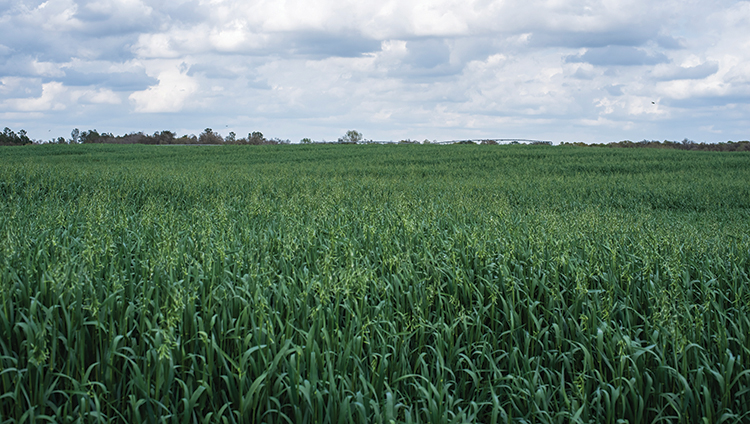
The challenging winters of recent years have impacted both alfalfa’s persistence and yield. This situation, coupled with building pressure on farms to be conservation-minded, has created renewed interest in growing forage crops such as rye or triticale immediately after harvesting corn silage. These crops can provide conservation benefits while supplying additional forage to feed dairy or beef cattle.
In 2018 and 2019, we conducted a pilot research project to study forage value and develop feeding guidelines for using rye and triticale in dairy rations. Here’s what we learned from the farms in our studies and a little guidance to help you on your way.
Top 3 challenges and opportunities
No. 1 — Harvest timing. The single greatest factor that will determine forage quality and quantity is harvest timing. As the crop matures, yield climbs, but forage quality drops. Be sure all of the farm team members are on the same page about harvest plans, including the farm owner, agronomist, nutritionist, and anyone else with a role in harvesting and feeding of rye or triticale. A clear, unified goal will be important from the start, and communication is key.
Harvest timing in 2018 and 2019 was around mid-to-late May for southern Wisconsin farms and early June for northeast Wisconsin farms if looking to harvest lactating cow feed. This often coincided with first-crop hay harvest, which also meant that labor and equipment resources were split between harvesting two crops at basically the same time. Harvest can be delayed if looking for heifer-quality forage, which can minimize overlap with first-crop harvest.
No. 2 — Storage. Adequate storage space is needed to make these crops work into a feeding plan. Ideally, rye or triticale would be stored separately from other high-moisture forages to better manage use. It’s usually easier to achieve this separation when using bags. Bags may not be an option if harvesting a more mature crop, as dried stems with high lignin levels do not pack easily.
Bunkers and piles also can work well with some farms layering rye or triticale with another haylage to minimize the number of different forages. In other instances, farmers have built a new storage space if finances allow. How the farm decides to handle storage availability will be specific to each operation, but the most important part is to take storage space into consideration.
No. 3 — Increased feed inventory and diversified forage options. Growing rye and/or triticale can provide another forage and help hedge some of the risk associated with alfalfa winterkill.
Nutrition recommendations
Rye or triticale? Samples from our pilot project did not show much difference between rye and triticale. This makes sense since triticale is a cross between rye and wheat. Also, our samples did not show significant changes in quality between fresh and ensiled forage.
When to harvest? For milk cows, harvest at the boot stage for a low-fiber, high-digestibility forage. Fiber digestibility can be very high and provide the optimal quality needed to support milk production. Yields at boot stage have varied between 1 to 2 tons of dry matter per acre.
If feeding to dairy heifers, the ideal time to harvest is between the heading to soft dough stage. This will provide a higher-fiber, lower-energy forage, which is great for pregnant heifers to minimize overconditioning. Harvesting at this later time will provide greater yield as well. Estimated yield is around 2.5 to 5.5 tons per acre based on work at the University of Wisconsin’s Marshfield Ag Research Station.
How much to feed? In our study, rye forage samples were collected and analyzed in the AMTS modeling software (agmodelsystems.com) to predict production from variable feeding rates for milk cows. Scenarios were run replacing both alfalfa and corn silage. We found high-quality ryelage best replaces alfalfa silage, while average- and low-quality ryelage was predicted to impede milk production if included in the diet.
Based on this work, it is predicted that feeding 5 pounds of high-quality ryelage should be able to replace alfalfa silage without lowering milk production. This can be a starting point when deciding how much to feed in the diet but will need to be adjusted based on animal performance. Always consult with your farm’s nutritionist before making any changes to the ration.
Planning ahead
It will be important for the farm to decide how the forage will be fed. Considerations include whether to feed all year round or part of the year, group(s) fed, inclusion levels in the diet, available storage space, labor, time, and money.
Ultimately, planning backwards will help provide the greatest success. Start with the animal performance factors such as milk production or rate of gain. Then figure out how much can be fed to achieve that performance metric. Calculate what that amounts to for feed inventory and if there’s available storage for it.
After that, think about when the crop needs to be harvested to meet quality goals and if it will fit inside what’s available for feed storage. Finally, determine how many acres need to be planted and the necessary crop inputs.
Regular communication will be key, especially as weather and crop maturity change. Having a clear game plan for prioritizing fieldwork will also be important. The rye or triticale harvest usually is competing with manure application, alfalfa harvest, and possibly the planting of other crops. It will be helpful to think about the big picture and what needs to be done to achieve your goals.
Lastly, manage your expectations. With any new practice, there is going to be trial and error. Work with others such as farmers, nutritionists, agronomists, and extension personnel who are familiar with managing these forages. They can provide some great resources and information to help as you troubleshoot problems.








